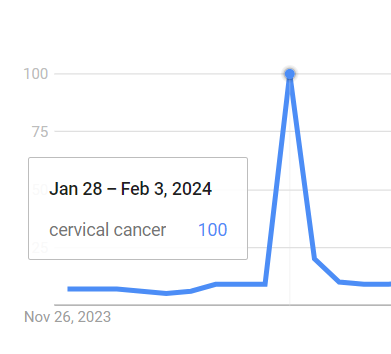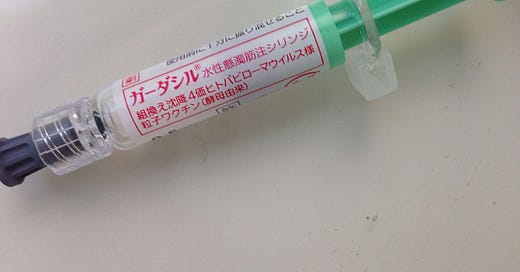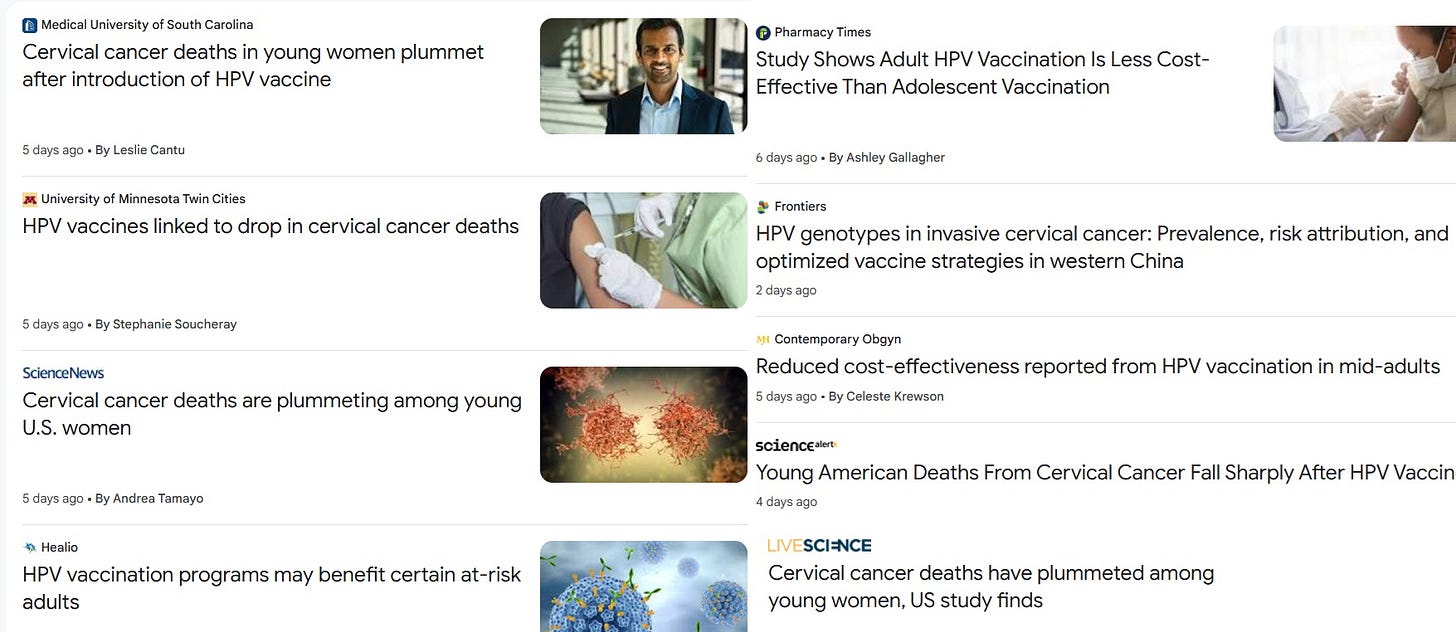New HPV vaccine push from the WHO
Something on the contemporary mechanics of pharmaceutical marketing
Several concerted efforts towards supporting mass vaccination against the HPV viruses have been launched over the recent months and weeks. The WHO provides the overarching framework of the campaign, together with a large number of dominant institutions such as UNICEF, the World Bank, the Clinton Health Access Initiative (CHAI), the Bill & Melinda Gates Foundation, and of course, Gavi.
Apart from the noteworthy fact that a focus on HPV provides a convenient and lucrative explanation for the otherwise peculiar rapid increase in cervical cancer among younger adults, there are a few significant issues surrounding this entire project:
Mass HPV vaccinations targeting strains already present in the population (vaccinating straight into an epidemic) carry significant risks; the notion of HPV as the most important cause of cervical cancer is somewhat tenuous; even successful mass vaccinations into a complex ecosystem of hundreds of different HPV viruses may at best be useless and potentially harmful in the long run; there are significant side effects associated with the treatments; unelected supranational bodies in alliance with nefarious multinational pharmaceutical companies that drive marketing and manipulate the media at their whim may possibly have conflicting interests related to profit.
And last but not least, the anti-HPV effort is by a remarkable coincidence about to become a launching pad for the next iteration of mRNA pharmaceuticals:
All of this is part of the latest phase in the WHOs and the World Health Assembly’s 2020 “global commitment” to eliminate cervical cancer through mass vaccination, with having 90% of all girls under the age of 15 inoculated as an objective. The reasoning is that targeted HPV vaccination before exposure through sexual intercourse will limit the prevalence of the strains of the virus that cause cancer of the cervix, and less commonly of other parts of the anogenital organs.
A recent press release by the WHO marked the start of this new wave in a joint international media campaign to bring renewed focus on the HPV vaccines with an stronger emphasis on their potential to eliminate cervical cancer.
It’s quite astonishing to see how mid-to-small-sized newspapers all across the Western world immediately followed suit, with incredibly timely in-depth interviews with medical experts, celebrities and cancer sufferers (thankful for the HPV tests saving their lives yet deeply regretting the free Gardasil jab which certainly would have spared them their illness), all coupled with op-eds painting a marvellous opportunity of finally eradicating cervical cancer if we only just roll out proper mass vaccinations against HPV.
Same thing in Norway (where there’s also a minor ongoing controversy around the government’s choice to maybe not use Merck’s new Gardasil 9 product, which generated pushback from the Norwegian Cancer Society). Same thing in Japan, where HPV vaccination was discontinued in 2013 due to safety concerns. Same thing in India. In the US. In the UK. In France. In Germany. And so forth.
It’s not always that the pattern of the media output so obviously makes clear a direct causal relationship between a top-down directive all the way down to local publications of interviews and “human interest” stories that obviously were prepared weeks and months beforehand. This is particularly noteworthy, since we’re clearly not only dealing with the basic, linear operations of the media as a propaganda apparatus that were well-known even in the 19th century, and which is perhaps best exemplified in how the major “news agencies” produced key messages or pieces of information that then tended to be reflected in regional and local news organs (for which they served as the main, if not only, conduits of international news).
This is a really instructive example in that what’s evident here is a much more sophisticated use of the news media, where there as a matter of course are layers upon layers of agents in several interlocking phases of the manufacturing of consent or of a desired pattern of popular behaviour, everying in accordance with the principles and practices of marketing.
So for the current HPV vaccine push, the overall process of this recent stage of the marketing programme could arguably look something like what follows:
2020-2022
the initiative starts up with press releases and marketing efforts to seed the entire project as such
crop of publications emphasizing the “dramatic” benefits of HPV vaccination
funding round to research organizations, health bodies and think tanks through intermediaries and associated organizations; nudged decisions by governments to promote the treatments
expansion of marketing campaign in the media, continuation of hype (e.g. Gavi’s “revitalization” of its HPV vaccination programme)

2023 - 2024
expansion of the marketing campaign enters the territory of fear-mongering, and the association between young people dying of cancer and HPV is strengthened, while the promise of prevention through vaccination is held out as a tangible hope and safeguard
second crop of publications from the previous funding round arrives, preferable research outcomes are marketed and boosted to promote the underlying agenda and assumptions; negative outcomes buried
decision-making bodies such as the Norwegian parliament get lobbied to expand vaccination campaigns and to purchase the appropriate pharmaceuticals (if they don’t go for Merck’s stuff, they get bullied by NGOs funded by the key players like Gavi (i.e. of which Merck is a major partner for promotion of the Gardasil brand))
And you top all of this off with something like the current media barrage to prepare the ground for your roll-out of the next generation of pharmaceuticals such as Cecolin and Walrinvax, or why not the mRNA-based mHTV-03E2 which purports to specifically target HPV-generated cancers through triggering a targeted immune response. Good old Gardasil is of course still in the game, now updated to target nine different strains of HPV all the while multiple lawsuits specifically regarding the vaccine are currently pending.
But again, apart from Merck being sued over Gardasil side effects, the HPV focus serving as a diversion for other potential causes of a surge in cancer and the ominous inclusion of the mRNA platform in near-future generations of HPV vaccines, why should we be wary of this development?
If carcinogenic HPV strains can be effectively suppressed by vaccines, and if this reduces the incidence of certain common cancers, that’s a pretty brilliant thing, right?
That would indeed be nice, but you really can’t eradicate the strains; and even if you could, that wouldn’t prevent other HPV variants emerging to fill the same carcinogenic niche in the mid-term; and the vaccines have serious side effects and are useless to the majority of the young women targeted by advertising.
If you’re infected by HPV, by one or more of the 9 strains that arguably have been shown to cause cancer, the vaccines are not going to be very useful. 80-90% of the adult population is already infected. 99% will be infected or have already had a virus. 50% of all actual HPV infections are with carcinogenic variants, and it’s anyone’s guess as to what percentage of the population has already been exposed to one or more of the cancerous strains.
There’s also cross-immunity between the various strains, which further impacts the rationale for a mass vaccination of an already exposed population (entirely apart from issues of triggering latent infections by activating and specifically suppressing the immune system that reacts to HPV proteins).
Also, about 200 variants of HPV have been discovered. You’re never going to eradicate even the 9 strains that are said to cause cancer since they’re endemic throughout the entire population. This would take an inoculation of every single child in the entire world (which is pretty much what they’re talking about) and that every carrier was singled out and mapped and forced to abstain from sexual relations for the rest of their lives.
But even if you eradicate these particular variants, you’re certain to get subsequent strains to fill the ecological niche that emerges (as we saw with “Omicron”), and the more than 200 remaining variants would naturally also mutate to enter this carcinogenic niche over time.
So maybe it’s a good idea to stop, look through the data really closely, and have a proper think about the cost-benefit issues here before we enthusiastically jab every nine-year-old girl on the planet with something that’s known, as with Gardasil that’s currently the standard treatment, to cause autoimmunity and fertility issues and even cervical cancer as such. And maybe we should be particularly wary about the HPV scare becoming a vehicle for the next iteration of mRNA.
Maybe lawmakers, journalists and researchers should finally start getting wise about the fact that pharmaceuticals marketing is primarily a business, a really dirty one, that in the very best of worlds is only tangentially related to public health and well-being.
Just a thought.







Ever wonder why medicine cannot understand the immune system?
https://barn0346.substack.com/p/you-dont-have-an-immune-system
I think the goal is to remove the cervix from the equation